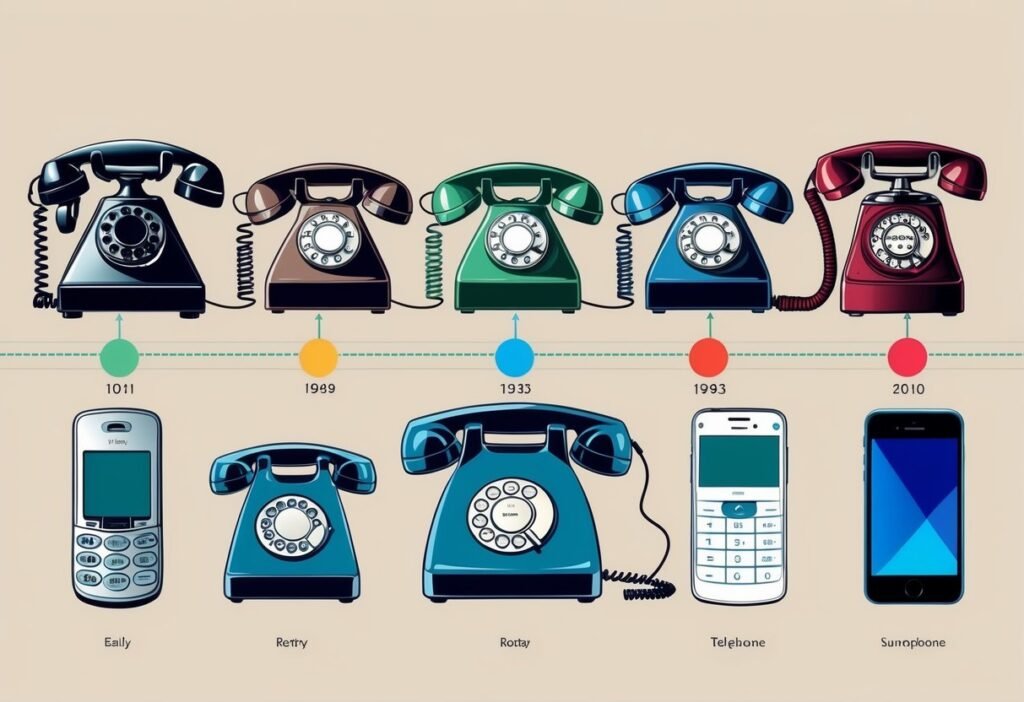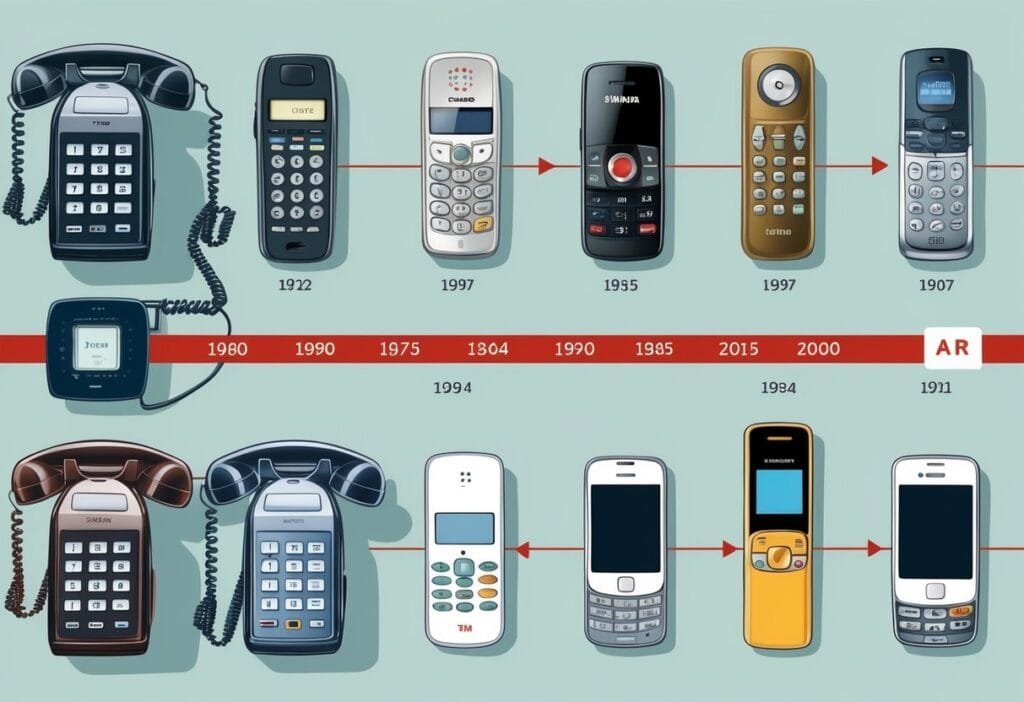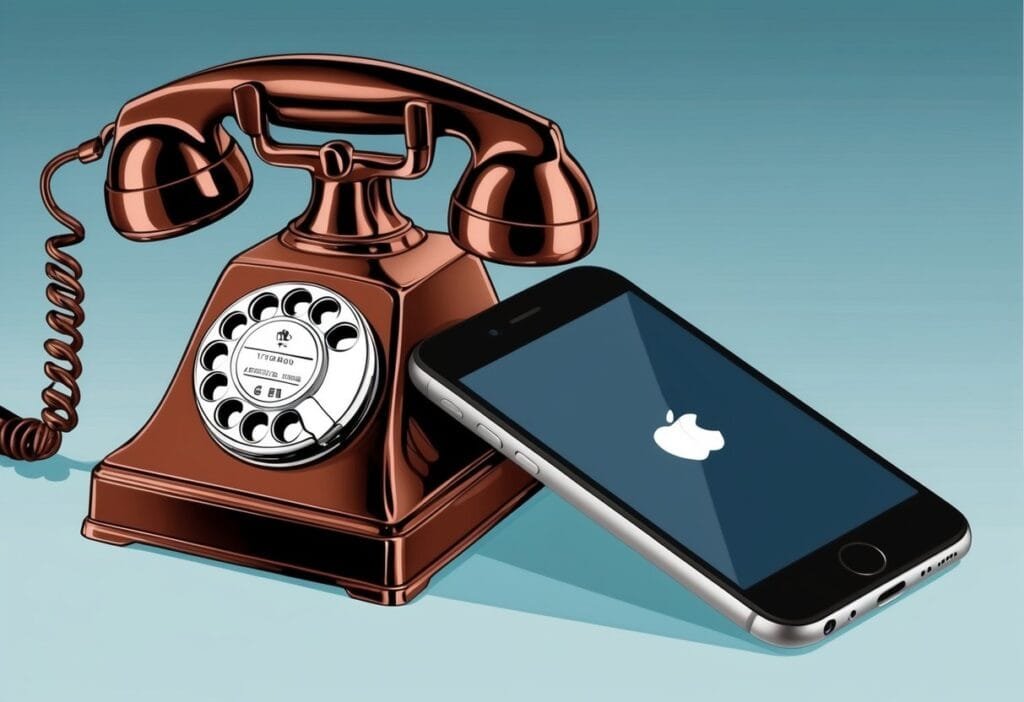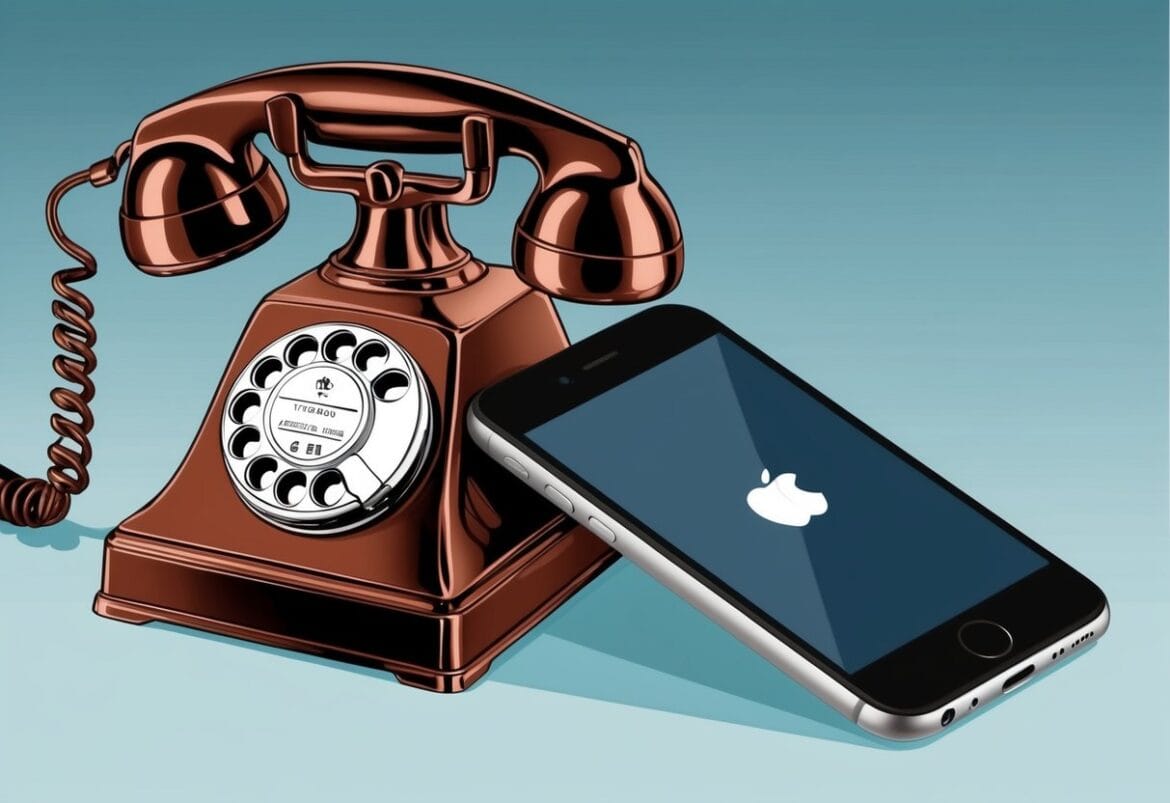Table of Contents
Explore the captivating evolution of telephone, from Alexander Graham Bell’s invention to today’s smartphones, and discover how communication has transformed over time.
The telephone has come a long way since its invention in 1876. This device changed how people communicate, bringing voices across vast distances. From simple wires and speakers to advanced digital systems, phones have evolved rapidly.
The telephone’s evolution spans from early fixed-line models to today’s smart devices, marking key milestones in communication technology. Alexander Graham Bell’s first phone used basic components like a transmitter and receiver. Over time, phones gained new features like rotary dials, touch-tone keypads, and wireless capabilities.
Modern smartphones combine multiple technologies. They offer voice calls, text messaging, internet access, and various apps. This evolution shows how phones have become central to daily life, far beyond their original purpose of voice transmission.
The Origins and Early Innovations

The word “telephone” comes from the Greek roots tēle, meaning “far,” and phonē, meaning “sound,” and literally means “distant sound”
The telephone’s development involved multiple inventors and key breakthroughs. Early acoustic devices paved the way for electrical systems, leading to a fierce race for the first working telephone patent.
Acoustic Pioneers: From String to Bell

The string telephone was an early acoustic device used by children. It helped people understand sound transmission. In 1667, Robert Hooke created a mechanical string phone. This simple tool showed that sound could travel through a taut string.
Alexander Graham Bell built on these ideas. He studied sound and speech as a teacher for the deaf. This background gave him unique insights into voice transmission. Bell’s work combined acoustics with emerging electrical technologies.
Bell’s experiments aimed to send multiple telegraph messages on one wire. This led him to explore voice transmission. He worked with Thomas Watson to create new devices.
Elisha Gray vs Alexander Graham Bell vs Thomas Edison Controversy
The race to invent the telephone was intense. On February 14, 1876, both Bell and Elisha Gray filed patent applications. Bell’s lawyer got to the Patent Office first, just hours before Gray.
Bell’s patent covered a method of transmitting speech electrically. Gray’s design used a water transmitter. The Patent Office awarded the crucial patent to Bell.
This decision sparked a major controversy. Gray challenged Bell’s claim. He said Bell stole his idea for the liquid transmitter. The legal battle lasted years. Courts ultimately upheld Bell’s patent rights.
Thomas Edison and Western Union also challenged Bell’s patent rights. These disputes slowed phone development for years.
The dispute shows how close the race was. All these inventors made key contributions to telephone technology. Their work helped launch a communication revolution.
The Birth of Modern Communication

The telephone revolutionized how people communicate. It allowed instant long-distance conversations and changed society forever.
The First Telephone Call
Alexander Graham Bell made the first telephone call on March 10, 1876. He spoke to his assistant Thomas Watson in the next room. Bell said, “Mr. Watson, come here. I want to see you.”
This simple message marked the start of a new era. The call proved that voice could travel over wires.
Bell’s device used a liquid transmitter. It had a diaphragm that moved when someone spoke into it. This created electrical signals that traveled through wires.
1876: A Key Year in Telephony
1876 was crucial for telephone development. Bell got his patent in March. He showed off the telephone at the Centennial Exposition in Philadelphia that year.
The Bell Telephone Company formed in July 1877. It started selling telephones and setting up exchanges.
Early phones could only connect two places directly. But soon, switchboards allowed more connections. This led to the growth of telephone networks.
By 1880, there were over 49,000 telephones in the United States. The technology spread quickly, changing how people lived and worked.
Evolution of Telephone Technology

Telephone technology has changed a lot over time. It went from using wires to being wireless. Phones also got smaller and more powerful.
From Analog to Digital Transition
The first phones used analog signals to send voices through wires. These worked well but had limits on sound quality and how far they could send calls.
Digital phones came later. They turned voices into ones and zeros. This made calls clearer and let phones do more things.
The change to digital happened slowly. First, phone networks went digital. Then the phones themselves became digital too.
Digital phones could send text messages and access the internet. This was a big step toward modern smartphones.
Development of Cordless and Mobile Phones
Cordless phones came out in the 1980s. They let people walk around at home while talking. Early ones didn’t work very far from the base.
Cell phones came next. They used radio waves to make calls from almost anywhere. The first ones were big and only made calls.
Mobile phones got smaller and smarter over time. They added features like texting, cameras, and internet access.
Smartphones appeared in the 2000s. They work like tiny computers. People use them for calls, apps, photos, and much more.
The Global Expansion

The telephone spread rapidly across countries and continents in the late 19th and early 20th centuries. This growth led to national telephone networks and the first international calls.
Emergence of National Networks
The first telephone exchange opened in 1878 in New Haven, Connecticut. It connected 21 subscribers. By 1880, there were 47,900 telephones in the United States.
telephone networks grew quickly in other countries too. The United Kingdom started its first exchange in 1879. Germany followed in 1881.
As networks expanded, telephone companies formed. The Bell Telephone Company became the largest in the U.S. It later turned into AT&T.
National phone systems needed standard equipment. This led to the creation of telephone manufacturing companies.
First Transatlantic and International Calls
The first transatlantic telephone cable was completed in 1956. It allowed calls between Europe and North America.
Before this, radio telephone services existed. But they were expensive and had poor quality.
The first transatlantic call happened on January 7, 1927. It was between New York and London.
International Bell Telephone Company, formed in 1879, helped spread telephone technology globally. It set up networks in Europe and South America.
By 1935, people could make calls to 93% of the world’s telephones.
Telecommunication Revolution

The telephone industry underwent major changes in the late 19th and early 20th centuries. New companies formed and technology improved rapidly. This led to wider access and better service for customers across the United States.
Rise of the American Telephone and Telegraph Company
In 1885, American Telephone and Telegraph Company (AT&T) was formed as a subsidiary of American Bell Telephone Company. AT&T took over long-distance services, while American Bell focused on local exchanges.
By 1899, AT&T became the parent company. It grew quickly by buying up local phone companies. This created a near-monopoly on telephone service in the U.S.
AT&T’s size allowed it to invest in research and development. In 1915, it completed the first coast-to-coast telephone line. This connected New York to San Francisco, spanning over 3,000 miles.
Automatic Exchanges and Early Service Providers
Early telephone systems relied on human operators to connect calls manually. This changed with the invention of automatic exchanges in the late 1800s.
Almon Brown Strowger patented the first automatic telephone exchange in 1891. His system used electromechanical switches to route calls without operators. This made phone service faster and more private.
By the early 1900s, many cities had competing phone companies. Customers often needed multiple phones to reach different networks. This led to a push for interconnection between rival systems.
In 1913, the U.S. government allowed AT&T to operate as a regulated monopoly. In exchange, AT&T agreed to connect its long-distance network with local carriers. This helped create a unified national telephone system.
Modern Technological Integration
Telephones have undergone major changes due to technological advances. These innovations have transformed how we communicate and connect with others across the globe.
Internet and Voice Over Internet Protocol
The Internet changed how phones work. Voice over Internet Protocol (VoIP) lets people make calls using the Internet instead of phone lines. This technology offers cheaper long-distance calls and new features.
VoIP services include:
- Skype
- Zoom
At first, VoIP relied on dial-up connections. These were slow and unreliable. Now, high-speed broadband allows for clear calls and video chats.
Many businesses use VoIP phone systems. They’re cheaper to set up and maintain than traditional phone lines. VoIP also makes it easy to add new lines or features as needed.
Fiber-Optic Innovations
Fiber-optic technology has greatly improved phone and internet speeds. Fiber cables use light to send data very quickly over long distances.
Fiber offers several benefits:
- Faster internet speeds
- Clearer phone calls
- More reliable service
- Higher bandwidth for multiple users
Fiber networks are replacing old copper wire systems in many areas. This upgrade allows for better quality calls and faster data transfer.
Many smartphones now work with fiber networks. This lets users enjoy faster mobile internet and clearer calls. As fiber expands, more people will have access to these improved services.
Challenges and Conflicts
The telephone’s development faced fierce competition and rapid technological change. These issues shaped the industry’s growth and direction.
Patent Disputes and Legal Battles
Alexander Graham Bell’s telephone patent sparked intense legal fights. Many inventors claimed they had created similar devices first.
Elisha Gray filed a patent on the same day as Bell. This led to a long court battle. The U.S. Supreme Court ruled in Bell’s favor in 1888.
Thomas Edison and Western Union also challenged Bell’s patent rights. These disputes slowed phone development for years.
Bell’s company aggressively defended its patents. This limited competition and innovation in the early telephone industry.
Technological Obsolescence and Adaptation
Phone technology changed quickly. This forced companies and users to adapt often.
Early phones used manual switchboards. Operators had to connect each call by hand. This system became impractical as phone use grew.
Automatic switching systems replaced manual boards. This made phone service faster and more efficient.
The move from rotary to touch-tone dialing was another big shift. It changed how people interacted with phones.
Landlines faced competition from mobile phones. This led to a decline in traditional phone use. Phone companies had to adapt their business models to survive.
Telephony in The Digital Age
The digital age brought rapid changes to telephone technology. Mobile phones and smartphones revolutionized how people communicate, offering unprecedented connectivity and features.
Transition to Cellular Networks
Cellular networks emerged in the 1980s, enabling truly mobile communication. The first commercial cellular network launched in Japan in 1979, followed by the Nordic countries in 1981.
In 1983, Motorola released the DynaTAC 8000X, the first handheld cellular phone. It weighed 2.5 pounds and cost $3,995. Battery life was limited to 30 minutes of talk time.
Cellular technology evolved quickly:
- 1G: Analog voice calls (1980s)
- 2G: Digital voice and text messages (1990s)
- 3G: Mobile internet and video calls (2000s)
- 4G: High-speed data and streaming (2010s)
- 5G: Ultra-fast speeds and low latency (2020s)
Smartphones: The Ultimate Convergence
Smartphones combined cellular phones with computing power, creating powerful mobile devices. The iPhone, introduced in 2007, popularized touchscreen interfaces and app ecosystems.
Key smartphone features include:
- High-resolution touchscreens
- Advanced cameras
- GPS navigation
- Mobile apps for various tasks
- Internet browsing
- Social media integration
Smartphones became essential tools for daily life. By 2024, over 7 billion smartphones were in use globally. They changed how people communicate, work, shop, and access information.
Voice calls became just one of many functions. Text messaging, video calls, and social media apps offered new ways to connect. The telephone evolved from a simple voice device to a pocket-sized computer.
Legacy and Cultural Impact
The telephone’s invention revolutionized communication and left a lasting mark on society. It shaped modern culture and became a staple in art and entertainment.
The Telephone’s Role in Modern Society
The telephone changed how people connect and do business. It broke down distance barriers, allowing instant communication across great distances. This led to faster information exchange and closer relationships.
In emergencies, telephones became lifelines. They enabled quick access to help and support. The creation of services like the Samaritans showed how phones could save lives.
Telephone technology evolved rapidly. It went from landlines to mobile phones to smartphones. Each step brought new ways for people to interact and share information.
Telephones in Art and Entertainment
Telephones became iconic symbols in popular culture. They appeared in countless movies, TV shows, and songs. The ringing phone created suspense in thrillers and comedic moments in sitcoms.
Artists used telephones as subjects in paintings and sculptures. These works often explored themes of connection and isolation. Phone booths became recognizable urban landmarks, featured in many films and photos.
In music, telephones inspired hit songs across genres. Lyrics about calling, waiting for calls, and phone conversations resonated with listeners. The sound of a ringing phone became a familiar audio cue in various media.
The Future of Telephony
The future of telephony is set to bring exciting changes to how we communicate. New technologies will reshape our phone experiences in the coming years.
AI-driven voice assistants will become more advanced. These digital helpers will manage calls, schedule appointments, and even engage in basic conversations on our behalf.
5G and future 6G networks will enable ultra-fast connections. This will support new features like high-quality holographic calls and immersive virtual reality meetings.
Smartphones will continue to evolve. They may integrate flexible screens, advanced biometrics, and even brain-computer interfaces for hands-free control.
Key future telephony trends:
- Seamless integration with smart home devices
- Enhanced security through quantum encryption
- Real-time language translation during calls
- Augmented reality overlays for video chats
The line between phones and other devices will blur. Wearable tech like smart glasses or implantable chips could take over some phone functions.
Environmental concerns will drive the development of more sustainable phone technologies. This includes eco-friendly materials and improved energy efficiency.
As telephony advances, it will become more personalized and intuitive. Phones will adapt to individual needs and preferences, creating tailored communication experiences for users.

